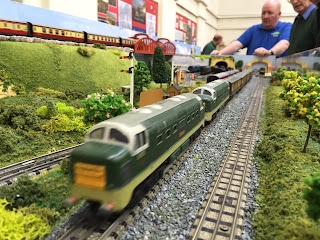A question that's come up a few times of late is how I get my locos to run double-headed, ie what tricks do I use, do I use unpowered dummies etc etc.
First of all, there is no cheating. All locos run under their own power. The only exception to this is the six car EMU whereby the rear three coaches are un-powered.
Double-heading, when it goes right, looks pretty impressive and can be achieved with reasonable ease if the following measures are observed:
1: Loco condition - nearly all of my locos are fitted with neo magnets and are well serviced. Most run well under 0.5 amps, which is critical for running in pairs. Check the current consumption of each locomotive individually. It may be necessary to run them for a few loops to warm up first. Total current consumption needs to be under 1 amp. This is where having ammeters is very handy.
2: Power - an A3 can just about manage a small rake of coaches and two locos. Power needs to be applied gradually and carefully to avoid tripping the controller and running speed is notably slower. Duette controllers are far less sensitive and can handle the job far better. My Trax feedback controllers, rated at 1.5 amps cope with the job just fine.
3: Track - needs to be spotless, no flat spots. If one of the two locos stalls at any point it will potentially uncouple or derail. More so with locos running rubber tyres - they don't do sudden stop / starts!
4: Loco speeds - rarely will two locos run at exactly the same speed - we're talking about over fifty years of wear & tear! Choose two locos that run at a similar speed. Run them together uncoupled at the speed you intend to run. Different motors and gearing can affect the speed at various power levels so run at the speed you intend to run and put the faster of the two at the front. This keeps the coupling between the locos under tension. If the faster loco is at the back it will potentially derail, especially if there are front and rear bogies involved.
A few gratuitous double-heading pictures below:
 |
| I cheated a little when I was producing the transfers for these 2-6-4 tanks - I chose the two chassis that ran the best together and numbered them in sequence! |
 |
| As with the Deltics, the Co-Bo's require careful stop / starts - one Co-Bo is currently out of action having shed two tyres! |






No comments:
Post a Comment